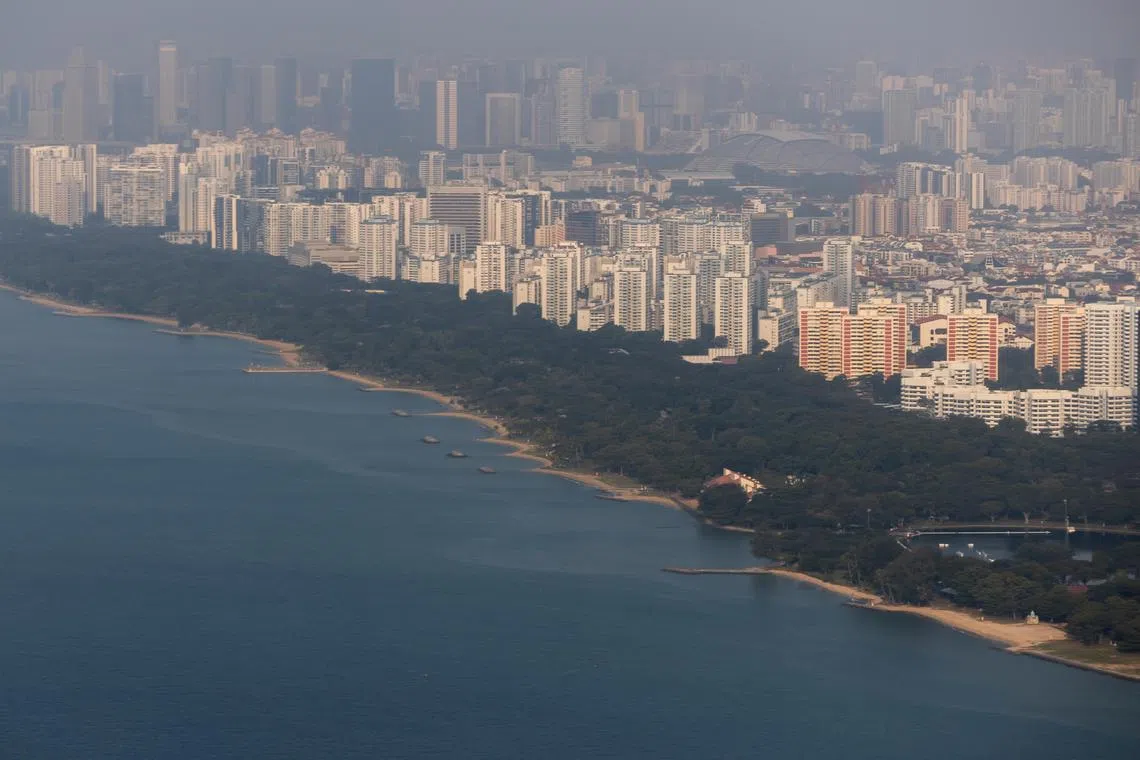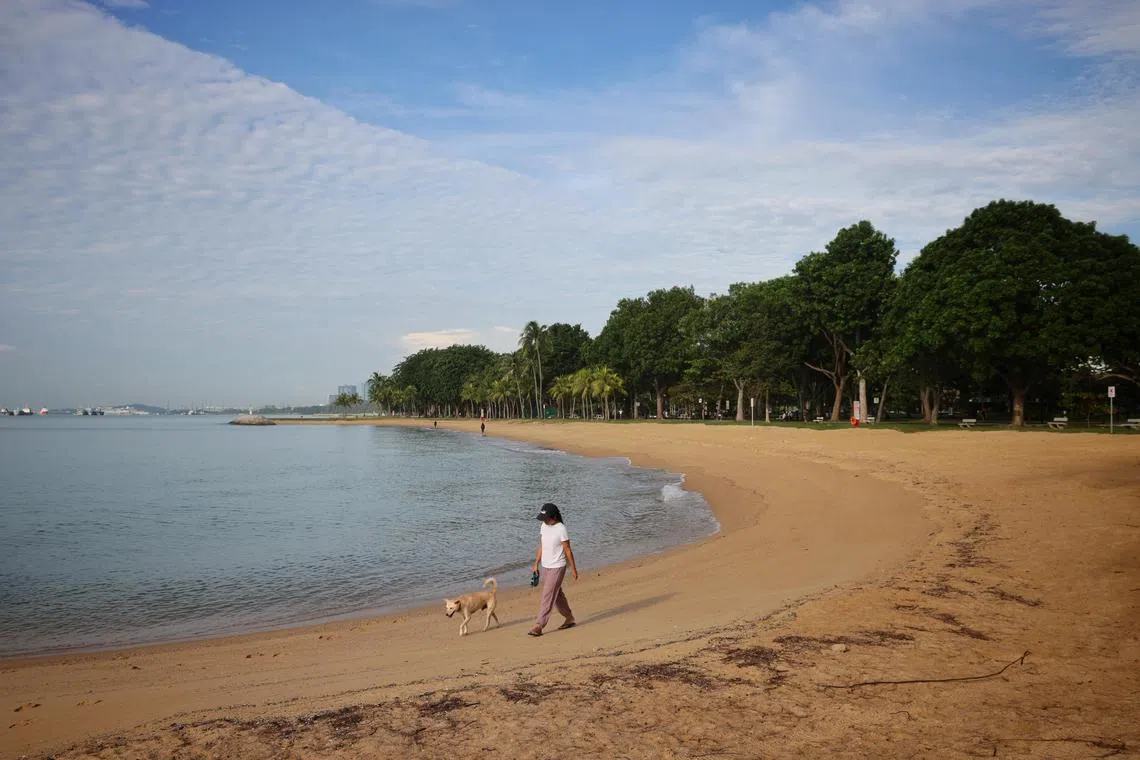Unlimited sea access, affordable housing among S’poreans’ wishes for upcoming Long Island
Sign up now: Get ST's newsletters delivered to your inbox

East Coast Park is currently the largest public access point to the sea.
ST PHOTO: GAVIN FOO
Follow topic:
SINGAPORE – Continued unlimited access to the sea, affordable housing and educational opportunities centred on coastal habitats are among the ideas and suggestions that Singaporeans have given at engagements on the Long Island reclamation project
Since the start of 2024, public agencies have held engagement sessions on plans for the project, which will help to meet several needs, such as coastal protection, flood resilience and boosting Singapore’s freshwater supply.
Technical studies, including environmental impact assessments, engineering studies and soil investigation works, will begin later in 2024 and last about five years, ahead of the development of the project, which is slated to yield about 800ha of land.
The Urban Redevelopment Authority (URA) said that between November 2023 and May 2024, agencies received more than 500 submissions via online public feedback channels, such as the URA website and by e-mail.
In addition, six engagement sessions have been held as at mid-May, involving East Coast residents and businesses, East Coast Park users, nature groups, sports and recreational groups, as well as members of the public.
National Development Minister Desmond Lee on May 14 hosted the sixth such engagement, which was the first to be opened to the public.
Temasek Junior College student Justin Goh, 18, was among the 60 participants at the session held at The URA Centre in Maxwell Road.
He said that among the ideas he raised was how to develop or reclaim Long Island – current conceptual plans show that it will comprise three land tracts – in a manner that is environmentally sustainable.
Citing studies that used ash mined from Semakau Landfill for Tuas Port’s reclamation, Mr Goh suggested that a similar approach be taken for Long Island, to minimise the environmental impact from the extraction of sand – the conventional fill used in reclamation.
Mr Goh also suggested that coastal habitats, such as tide pools, brackish water and mangrove habitats could be formed on the new island, which could give future users direct contact with nature, and serve educational purposes.
Echoing Mr Goh’s sentiments was Ms Izavel Lee, who represented environmental group LepakInSG at the May 14 engagement.
She was primarily concerned about Long Island’s impact on biodiversity – especially during its construction phase – and hopes that the environmental studies would thoroughly document and suggest mitigating measures to protect marine life
Besides minimising species loss, Ms Lee hopes the authorities will look into designing Long Island such that marine life can return and recover in the area over time, after the new land is established.
URA said that through the upcoming technical studies, agencies will explore combining engineering and nature-based solutions to develop innovative designs that will “better integrate coastal protection measures with land reclamation”.
Mr Goh said other attendees at the May 14 engagement raised issues such as accessibility between Long Island and the mainland, as well as between the island’s land tracts.

Members of the public had expressed a desire for continued unrestricted access to the sea on the future Long Island.
PHOTO: ST FILE
Also on participants’ minds, he added, was the hope that the decision-making processes on Long Island would be transparent, and continue to be open for citizen participation.
Singapore Sailing Federation chief executive Leslie Tan, who attended an engagement session in February, said he was most concerned that access to the sea would be limited when Long Island is developed, adding that losing access “would be devastating” for the sea sports community.
Mr Tan noted that free and open access to the sea is now challenging, with only about 10 per cent of the shoreline allowing sea access – East Coast Park being the largest such opening.
Mr Tan said the waters off East Coast provide the safest conditions in Singapore for a full range of sea sports, and accommodate those of all abilities, from beginners to world-class athletes.
He added that the area is where various regattas, events and races – about 50 yearly, including activities such as sailing, stand-up paddleboarding, and triathlons – are held, which are “important for developing a vibrant, active and healthy nation”.
He said the federation is discussing with the authorities how access to the sea might continue when the construction of Long Island eventually starts.

National Development Minister Desmond Lee greeting a participant at an engagement session on the Long Island project at The URA Centre on May 14.
PHOTO: MINISTRY OF NATIONAL DEVELOPMENT
Addressing participants at the engagement session on May 14, Mr Lee noted that the Long Island projects will take decades to be completed, adding that the Government will work with various groups at each stage of planning, and that “the process is as important and as impactful as the final outcome”.
“With each stage, we are going to create something and we have to decide what to do with the piece of land that we start to develop,” he said, noting that not all of it has to be for economic gain, and that the exact use of the land can be discussed, or even left “to the future generation to decide what they want to use this land for”.
But referencing rising sea levels, Mr Lee emphasised that the Long Island project is primarily an issue of coastal protection, and not reclamation for the sake of creating land for more opportunities.
“By the end of this century, we had better get this up, because that element of national security is not for compromise, is not negotiable, for the sake of our continued existence,” he said.


